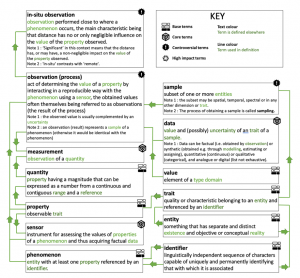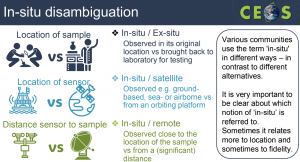CEOS Common Dictionary
Earth Observation (EO) is a highly interdisciplinary field, encompassing expertise from sensor development to data processing and decision-making support. A precise use of terminology is required to communicate this expertise effectively, and to support the dissemination of information and interpretation of data. The various communities of EO, shaped by their viewpoints and legacies, have independently developed vocabularies to define critical terminology. When compared, these definitions can be inconsistent, controversial, and superficial. This establishes the need for common vocabularies and an interoperable dictionary that is consistent, interrelated, understandable, educational, and updateable.
To address the difficulties of terminology within satellite EO, a Terminology Task Group was set up by CEOS in 2021. In 2024, the group concluded their initial work with the publication of a paper: “Lost in Translation: The Need for Common Vocabularies and an Interoperable Thesaurus in Earth Observation Sciences”. The study found that while many good but isolated dictionaries exist, implementing an interoperable dictionary requires a coordinated effort endorsed by all stakeholders.
The vocabularies used across CEOS groups and Agencies were collated, which highlighted that many vocabularies do not meet the definition of a ‘structured vocabulary’, defined by the International Standards Organisation (ISO) as an “organised set of terms, headings or codes representing concepts and their inter-relationships, which can be used to support information retrieval” (ISO 25964-1 2011). These vocabularies often lacked structure, cross-links, and version control, making them hard to navigate and prone to misinterpretation. While some vocabularies like the ISO Geolexica and SWEET incorporate hierarchical or ontological relationships, they remain poorly accessible or inadequate for interdisciplinary use.
In their paper, the Task Group considered three case studies focused on fundamental terms defined by these vocabularies: ‘observation’, ‘in-situ’, and ‘interoperable.’ Each of these terms has historically faced difficulties in their definition. These were representative examples of issues identified in a much wider list of terms considered by the Task Group.
‘Observation’ is a fundamental term to the Earth sciences, yet is often ambiguously defined both as a process and its result. Furthermore, some scientists working with satellite intend to distinguish ‘measurement’ and ‘observation’ based on processing levels, while other scientists, and indeed some international standards do not distinguish ‘observation’ and ‘simulation’. These different confusions create significant ambiguity when using the word.
In satellite remote sensing, the term ‘in-situ’ commonly refers to any high-fidelity data collected close to the observed phenomenon. This has led to the term being defined both as a measurement ‘at the actual location’ (NASA) and as ‘any sub-orbital measurement’ (CEOS). The assumption of an equivalent understanding of the term becomes critical when it implies the inclusion or exclusion of certain types of observations. Where a distinction matters, the distinctive criterion (e.g. location, distance, or quality) should be specified instead of the unqualified term ‘in-situ.’
‘Interoperability’ is a widespread term and a desirable attribute for datasets, which covers a broad number of concepts each of which uses tailored definitions of the term. For EO datasets, ‘interoperability’ can include the use of common geospatial grids, coefficients to correct biases, and the homogenisation of data between satellite sensors. Rather than a definition of ‘interoperability,’ communities would benefit from an interoperability framework that defines which factors they consider relevant to their context. CEOS WGISS has developed an Interoperability Framework that identifies five factors needed to move towards greater interoperability of EO assets. CEOS is now developing an Interoperability Handbook to expand on the framework; contributions from the community are welcomed via the GitHub repository.
The CEOS Terminology Task Group identified the following criteria for an interoperable vocabulary:
-
The approach to converge across all stakeholders into a common vocabulary that is collectively governed by the main stakeholders, with version control at the individual term level.

The Task Group presents an initial set of interrelated terms built on a careful selection of base terms.
- A structure of terms, consisting of the following classification:
- ‘Base terms’ which are foundational terms commonly used in the definition of other terms.
- ‘Core terms’ for core Earth sciences vocabulary. A subset of these core terms would be ‘controversial terms’ which are used differently by separate communities.
- ‘High-impact terms’ which can only usefully be defined in comprehensive framework descriptions.
- The content of the thesaurus is compiled.
- The practical steps towards this initiative must build on existing efforts, with the support of professional tools, technical experts, and links to more complex frameworks for high-impact terms.
The principles laid out by the Task Group’s paper have been adopted by the Knowledge Centre on Earth Observation (KCEO) of the European Commission (EC), with the implementation of an EO glossary housed in GitHub. The KCEO Glossary of Terms and Definitions is a living document that aims to serve as a reference for everyone involved in Earth Observation. KCEO and CEOS welcome all community participation to the development of this glossary, which is available here: https://ec-jrc.github.io/KCEO-Glossary/
Once developed sufficiently, CEOS considers to adopt this glossary as the fundamental reference for all CEOS activities.
Read the full paper by the CEOS Terminology Task Group: Lost in Translation: The Need for Common Vocabularies and an Interoperable Thesaurus in Earth Observation Sciences
